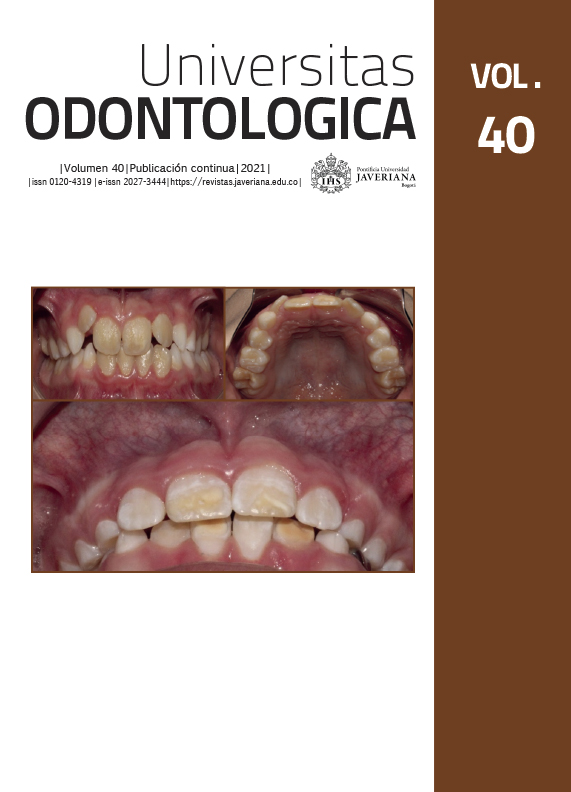Abstract
Background: Frenula are fold-like structures of connective tissue that are inserted into the upper jawbone. This anatomical structure, which often goes unnoticed during the oral exam, presents insertion variations that are associated with diastemas, phonetic, periodontal, and orthodontic issues. Purpose: To identify the type of upper labial frenulum insertion associated with the presence of diastemas, in students aged 8 to 15 who attend the Vicente Anda Aguirre Educational Unit of the Mocha Canton, Ecuador. Methods: A descriptive study with a cross-sectional observational design, with a sample of 300 8-to-15-year-old children, who met the inclusion and exclusion criteria, was carried out. A clinical examination and photographic records of the upper labial frenulum were carried out/obtained to analyze the variables: type of insertion and presence of diastemas in relation to age and gender. Through Chi square test and linear regression, the association between these variables was evaluated (p = 0.05). Results: 44.67 % presented an upper lip frenulum with gingival insertion. Penetrating papillary insertion was found in 27.54% and was more closely related to the presence of diastema, with the mild type being the one that occurred most frequently (66.67 %) regardless of sex. Conclusions: Age showed a close relationship with the frenulum insertion site, being its most coronal location at an early age. Therefore, it could be a predisposing factor for the appearance of diastemas.
Mirko P, Miroslav S, Lubor M. Significance of the labial frenum attachment in periodontal disease in man. Part 1. Classification and epidemiology of the labial frenum attachment. J Periodontol. 1974 Dec; 45(12): 891-894. https://doi.org/10.1902/jop.1974.45.12.891
Boutsi EA, Tatakis DN. Maxillary labial frenum attachment in children. Int J Paediatr Dent. 2011 Jul; 21(4): 284-288. https://doi.org/10.1111/j.1365-263X.2011.01121.x
Oquendo A, Brea L, David S. Diastema: correction of excessive spaces in the esthetic zone. Dent Clin North Am. 2011 Apr; 55(2): 265-281. https://doi.org/10.1016/j.cden.2011.02.002
Devishree, Gujjari SK, Shubhashini PV. Frenectomy: a review with the reports of surgical techniques. J Clin Diagn Res. 2012 Nov; 6(9): 1587-1592. https://doi.org/10.7860/JCDR/2012/4089.2572
Upadhyay S, Ghimire N. Attachment of maxillary labial frenum in Nepalese children. Orthod J Nepal. 2013 Jun; 2(1): 38-31. https://doi.org/10.3126/ojn.v2i1.9291
Delli K, Livas C, Sculean A, Katsaros C, Bornstein MM. Facts and myths regarding the maxillary midline frenum and its treatment: A systematic review of the literature. Quintessence Int. 2013 Feb; 44(2): 177-187. https://doi.org/10.3290/j.qi.a28925
Abrahams R, Kamath G. Midline diastema and its aetiology—a review. Dent Update. 2014 Jun; 41(5): 457-464. https://doi.org/10.12968/denu.2014.41.5.457
Mohan R, Soni P, Gundappa M, Krishna M. Proposed classification of medial maxillary labial frenum based on morphology. Dent Hypotheses. 2014 Mar; 5(1): 2-6. https://doi.org/10.4103/2155-8213.128108
Suter VGA, Heinzmann A-E, Grossen J, Sculean A, Bornstein MM. Does the maxillary midline diastema close after frenectomy? Quintessence Int. 2014 Ene; 45(1): 57-66. https://doi.org/10.3290/j.qi.a30772
Díaz A, Puerta MA, Verbel J. Manejo quirúrgico de frenillos labiales sobreinsertados: reporte de caso. Rev Salud Bosque. 2015 Ago; 4(1): 69-74. https://doi.org/10.18270/rsb.v4i1.33
Castro-Rodríguez Y, Grados-Pomarino S. Relación entre frenillos labiales y periodonto en una población peruana. Rev Clin Periodon Implantol Rehabil Oral. 2016 Oct; 6(2): 24-34. http://dx.doi.org/10.1016/j.piro.2016.09.006
Guerrero BE. Revisión para el manejo del frenillo Labial. Rev Med Basadrina. 2016 Oct; 10(2): 52-57. https://doi.org/10.33326/26176068.2016.2.606
Jindal V, Kaur R, Goel A, Mahajan A, Mahajan N, Mahajan A. Variations in the frenal morphology in the diverse population: A clinical study. J Indian Soc Periodontol. 2016 Jul; 20(3): 320-323. https://doi.org/10.4103/0972-124X.182598
Sękowska A, Chałas R. Diastema size and type of upper lip midline frenulum attachment. Folia Morphol (Warsz). 2016 Oct; 76(3): 501-505. https://doi.org/10.5603/FM.a2016.0079
Santa Maria C, Aby J, Truong MT, Thakur Y, Rea S, Messner A. The superior labial frenulum in newborns: What is normal? Glob Pediatr Health. 2017 Jul; 10(4): 1-6. https://doi.org/10.1177/2333794X17718896
Castro-Rodríguez Y. Tratamiento del frenillo aberrante, frenectomía y frenotomía. Revisión de tema. Rev Nac Odontol. 2017; 14(26): 1-10.
Dasgupta P, Kamath G, Hs S, Babshet M, Doddamani L. Morphological variations of median maxillary labial frenum: A clinical study. J Stomatol Oral Maxillofac Surg. 2017 Dec; 118(6): 337-341. https://doi.org/10.1016/j.jormas.2017.06.018
Jonathan PT, Thakur H, Galhotra A, Galhotra V, Gupta N. Maxillary labial frenum morphology and midline diastema among 3 to 12-year-old schoolgoing children in Sri Ganganagar city: A cross-sectional study. J Indian Soc Pedod Prev Dent. 2018 Sep; 36(3): 234-239. https://doi.org/10.4103/JISPPD.JISPPD_51_18
Prasad KN, Sabrish S, Mathew S, Shivamurthy PG, Pattabiraman V, Sagarkar R. Comparison of the influence of dental and facial aesthetics in determining overall attractiveness. Int Orthod. 2018 Dec; 16(4): 684-697. https://doi.org/10.1016/j.ortho.2018.09.013
Encalada Verdugo L, Garcia-Rupaya CR, Del Castillo López CE. Calidad de vida relacionada a la salud oral en escolares del sector urbano y rural. Cañar, Ecuador. Rev Estomatol. Herediana. 2018 Jul; 28(2): 105-114. https://doi.org/10.20453/reh.v28i2.3326

This work is licensed under a Creative Commons Attribution 4.0 International License.
Copyright (c) 2021 Christian Paul Ocaña Caluña, Sandra Magdalena Macías Ceballos


